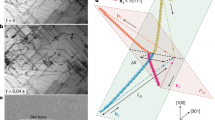Abstract
DURING the past three years I have collected evidence (now being published, submitted July 1949) that a new kind of slip is common in crystals. It is proposed to call it ‘rotational slip’, and it can be defined as the slipping of one part of a crystal on a neighbouring part, so that the two atomic sheets which slide over one another are densely populated planes, as in translational slip, but rotationally displaced about an axis normal to their plane (with or without simultaneous translational displacement) to one of a series of definable new positions where metastable equilibrium can occur. There is then only a two-dimensionally periodic partial fitting together of the two crystal parts. Neither the occurrence nor the nature of such slip has been clearly demonstrated hitherto.
This is a preview of subscription content, access via your institution
Access options
Subscribe to this journal
Receive 51 print issues and online access
$199.00 per year
only $3.90 per issue
Buy this article
- Purchase on Springer Link
- Instant access to full article PDF
Prices may be subject to local taxes which are calculated during checkout
Similar content being viewed by others
References
Dyson, J., Proc. Roy. Soc., A, 199, 130 (1949).
For example, in Finch, G. I., and Wilman, H., Ergeb. exakt. Naturw., 16, 353 (1937), fig. 66.
Hillier, J., and Baker, R. F., J. App. Physics, 17, 12 (1945).
Barrett, C. S., “The Structure of Metals” (New York: McGraw-Hill, 1943).
For further confirmation of rotational slip in such cases see Evans, D. M., and Wilman, H., letter in Proc. Phys. Soc. (in the press).
Heidenreich, R. D., and Shockley, W., J. App. Physics, 18, 1029 (1947), and Report on the Conference (1947) on “Strength of Solids”, 57 (London: Phys. Soc., 1948), suggested rotation of Al {111} translational-slip lamellæ on each other, but their electron-diffraction patterns appear to show rotational slip on {100}, thus probably ‘deformation bands’.
Germer, L. H., Phys. Rev., 50, 659 (1936). Beukers, M. C. F., Rec. Trav. Chim. Pays-Bas, 58, 435 (1939).
Raether, H., Métaux et Corrosion, 22, 2 (1947).
Whitmore, E. J., Ph.D. thesis (London Univ., 1939).
Gaubert, P., Bull. Soc. Franc. Minéral., 19, 431 (1896). Schaskolsky, M., and Schubnikow, A., Z. Kristallogr., 85, 1 (1932). Friedel, C., Bull. Soc. Franc. Mineral, 56, 262 (1933). Deicha, G., Experientia, 4, 67 (1948).
Author information
Authors and Affiliations
Rights and permissions
About this article
Cite this article
WILMAN, H. Rotational Slip—a New Deformation Process in Crystals. Nature 165, 321–322 (1950). https://doi.org/10.1038/165321b0
Issue Date:
DOI: https://doi.org/10.1038/165321b0
This article is cited by
-
Electron Diffraction Pattern of Mica of Various Thicknesses
Nature (1955)
-
Flexural Rotational Slip as the Main Deformation Process in the Torsion of Zinc Crystals
Nature (1955)
-
Stress Analysis of a Single Crystal in Pure Torsion
JOM (1955)
-
Surface Effects in the Slip and Twinning of Metal Monocrystals
JOM (1952)
Comments
By submitting a comment you agree to abide by our Terms and Community Guidelines. If you find something abusive or that does not comply with our terms or guidelines please flag it as inappropriate.



